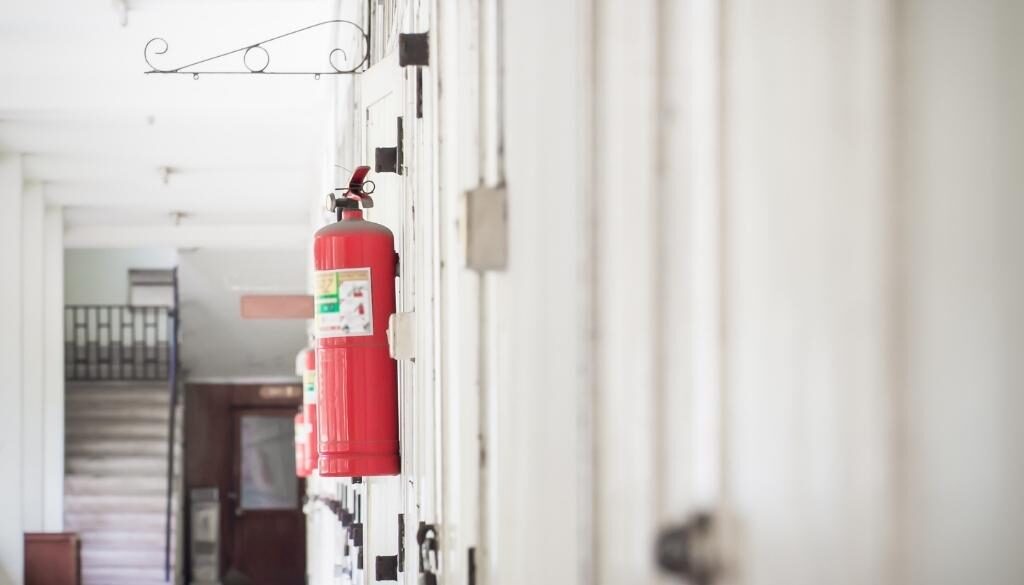Fire Watch Procedures: When And How It’s Required
A well-organized fire watch keeps a close eye on structures during risky activities or while fire protection impairments are corrected
So, the fire marshal issued the dreaded order: your property needs a fire watch. This is often done when a fire alarm, fire sprinkler, standpipe, or other fire protection system is out of service due to damage or scheduled maintenance.
Fire watches can feel overwhelming to many property owners and they can also be expensive, given the diversion of manpower or hiring of outside contractors to keep a watchful eye on the building. But the execution of one while a fire protection system is undergoing quick repairs or revisions should be straightforward—when it’s organized properly.
In this blog, we shed light on this oft-misunderstood and underappreciated fire prevention technique, including when fire watches are needed and who should carry them out. And we will dig into the details of what’s required so building owners can execute a fire watch with confidence and in compliance with codes, standards, and laws.
Why Would I Need A Fire Watch?
The 2018 edition of NFPA 101: Life Safety Code (3.3.108) defines a fire watch as the assignment of one or more people to the following tasks:
- Notifying the fire department and building occupants of an emergency
- Preventing a fire from occurring
- Extinguishing small fires
- Protecting the public from fire or life safety dangers
NFPA standards and the International Fire Code (IFC) maintain four reasons property owners may be required to implement a fire watch:
Fire Watch Reason 1: A building’s fire alarm, fire sprinkler, or fire suppression system is impaired, or an outage is preplanned that’s expected to last a significant amount of time
NFPA 25: Standard for the Inspection, Testing, and Maintenance of Water-Based Fire Protection Systems classifies an impairment as a serious issue that threatens life safety by rendering all or part of a fire protection system inoperable until it’s repaired (3.3.21). A property is rarely more vulnerable to catastrophic fire loss than when a fire protection system or a portion of a system is out of order.
Whether the impairment is caused by an emergency situation such as a ruptured pipe or is part of preplanned repairs, testing, or maintenance doesn’t matter. NFPA 25 Handbook: ITM of Water-Based Fire Protection Systems asserts that many devastating fires could have been avoided if a proper impairment program had been implemented that:
- Identified the risks created by the impairment
- Established a fire watch and backup fire protection
- Mitigated ignition sources and/or shut down hazardous processes
- Expedited repairs
- Ensured that the fire protection system was properly restored to service
The local authority having jurisdiction (AHJ), often a fire marshal, ultimately determines whether a fire watch is needed for parts of a property left unprotected by an impairment. Its decision is based on factors that include the level of impairment, the amount of time the system might be out of service, the type of hazard without protection, the potential for an uncontrolled fire, and any risk to the community.
NFPA 72: National Fire Alarm and Signaling Code mandates that the AHJs must be informed if fire alarm systems are inoperable for more than eight hours so appropriate mitigating measures can be determined, from simple occupant notification to fire watches. In the case of alarms, AHJs also weigh the occupancy type, the duration of the impairment, the building occupancy level during the impairment period, whether active work is being conducted on the fire alarm system during the impairment, the condition and features of other fire protection systems, and the assets at risk.
NFPA 25’s fire watch requirements for water-based fire protection systems may be triggered if the system or its components are out of service for more than 10 hours in a 24-hour period—regardless of the nature of the impairment.
Many AHJs maintain even tougher standards, requiring fire watches, building evacuations, or standby firefighters with ready apparatus if fire protection systems are out of service for more than 4 hours in a 24-hour period. To most property owners, fire watches are a gentler requirement than building evacuations, which can be disruptive to business.
Reason 2: Hot work will be occurring in the building
While “hot work” is most typically associated with welding and cutting, it can mean any type of work that produces a spark or flame, including using a torch or grinding. Hot work is a leading cause of industrial fires and has triggered many other building fires as well, such as this massive 2017 blaze in Brighton, Colo. that destroyed three businesses. Watch the news clip below to see the devastation caused by welding work in an auto body shop in the building:
Between 2013 and 2017, U.S. fire departments responded to an annual average of 4,630 fires incited by hot work, NFPA reports, causing an average of 15 deaths, 198 injuries, and $355 million in direct property damage every year.
Hot work can throw sparks and molten material more than 35 feet during welding, cutting, and grinding. These sparks and hot slag are typically burning above 1,000°F—more than enough to easily ignite paper, wood, flammable liquids, vapors, and any other combustibles in the area.
Unfortunately, there are few locations in the average facility that consistently lack combustible materials within 35 feet in all directions. Cracks in floor openings and ducts can transmit sparks to hidden locations as well. The intense heat generated by hot work can also ignite nearby combustibles, such as walls with combustible coverings or insulation.
Fire watches are required during any hot work activity and for at least 30 minutes after the work is completed in order to reduce the potential for ignitions and large fire losses. There’s a single exception: when there are no fire hazards or combustible materials in the hot work area.
Reason 3: During construction or demolition of a building
Construction fires account for less than 2 percent of U.S. structure fire responses and 3.2 percent of annual losses, according to a Fire Engineering magazine report. But their economic impact is estimated at $310 million a year, including abandoned projects, environmental damage, and increased insurance costs.
Fires can quickly spiral out of control on construction or demolition sites since fire alarms and fire sprinklers aren’t connected, water supplies may be shut off, and sparks from power tools can ignite nearby combustible materials.
In January 2019, the International Code Council (ICC) approved changes to the 2021 edition of the International Fire Code (IFC) designed to better safeguard construction sites. Chief among the coming changes is a mandatory fire watch during nonworking hours for new construction taller than 40 feet or with an aggregate area exceeding 50,000 square feet. Fire Engineering reports that these buildings were deemed “large enough to create a significant loss to the community, endanger firefighters, and consume resources” if they burn.
Currently, AHJs can mandate fire watches during hazardous construction or demolition activities such as temporary heating or hot work, or during nonworking hours when new construction exceeds 40 feet in height. Temporary heating devices are important to monitor on construction and demolition sites because materials are constantly being moved, potentially creating unsafe clearances.
Reason 3: Dense crowds are expected during events in public assembly buildings
Few can forget the painful lessons of The Station nightclub fire in 2003, when sparks from a pyrotechnic display caused soundproofing material to burst into flames during a concert. More than 460 fans had crowded into the Rhode Island nightclub to enjoy a heavy metal band. Four minutes after the fire started, the unsprinklered, wooden building was engulfed in flames. In the chaos that ensued, 100 people were killed and 200 more were injured.
Fire codes permit AHJs to require fire watches for extra crowd protection in public assembly buildings based on the number of people gathered or the nature of the event.
How Do I Conduct A Fire Watch?
In a nutshell, a fire watch consists of one or more trained personnel charged with maintaining life safety by continuously patrolling all areas of a property affected by an impairment or other fire watch condition. If smoke, fire, or other abnormal conditions are spotted, the fire watcher must immediately contact emergency personnel, alert building occupants, and help evacuate the building.
The main responsibilities of a fire watch include:
- Searching diligently for fires
- Immediately addressing any hazards that are discovered
- Controlling fire ignition sources
- Making sure there’s adequate means of egress and removing any obstructions
- Making sure other alarm systems are functioning properly
- Standing ready to contact the local fire department
- Standing ready to extinguish any fires using a portable fire extinguisher or hose
- Alerting occupants to hazardous conditions that require evacuation
- Documenting patrols at least once every hour
Fire watch patrols should systematically cover the impacted area every hour, documenting their findings at the completion of each round. It’s important to note that fire watchers’ responsibilities don’t stop with occupied areas of a building. They must also check unoccupied areas such as storage rooms, crawl spaces, and concealed places.
Fire watchers should be trained to understand hazards at the site and the nature of any hot work being conducted. They should have the authority to stop hot work if unsafe conditions develop as well. They must also be trained on how to fill out fire watch log sheets since fire codes require the thorough documentation of all activities associated with a fire watch.
Fire watchers should know the location of manual fire alarm stations and understand the sequence of events required for fire response and sounding alarms. They must have formal training in the proper use of emergency safety equipment and be able to easily access it. That said, fire watchers should only attempt to extinguish a fire if it’s plausible with the available equipment.
Failure to complete these guidelines can cause the local AHJ to impose fines or require building evacuations until fire watch conditions are resolved.

Who Can Conduct A Fire Watch?
Building owners essentially have two options for performing fire watches: using building staff or outsourcing the responsibility to a security company or fire protection contractor. For instance, the University of Alabama’s policy asserts that contractors should be responsible for fire watches if any work they perform on a fire protection system requires them to take it offline.
To best perform their duties, people assigned to a fire watch should be familiar with the building or premises and have access to all areas. They should have received formal training in the proper use of fire extinguishers and other emergency fire protection equipment, and they should fully understand emergency evacuation procedures, safety plans, and alarm activation procedures.
IFC (3304.5.2) permits fire watchers to simultaneously perform security duties on construction sites. But in all other instances, people assigned to a fire watch must forego all other responsibilities while it’s in progress. That means employees who typically perform maintenance duties can’t perform one while cleaning floors, and security guards working the door at public events can’t also be asked to keep an eye out for fires. This is an important consideration because fire watches must be conducted continuously during an outage—and potentially for an extended period of time.
Property owners who aim to assign fire watch duties to employees should follow the federal Occupational Safety and Health Administration (OSHA) requirements (1915.504). Besides requiring detailed training in how to conduct a fire watch, OSHA requires employers to develop and maintain a written policy that includes:
- The duties employees must perform
- The equipment they need
- The personal protective equipment (PPE) they must wear
Assigning fire watch duties to building staff instead of hiring security companies or contractors typically costs less up front and ensures fire watchers are familiar with the property. But property owners should carefully weigh these advantages against the cost of lost productivity when employees are removed from their regular duties, training and equipment costs, and potential legal liabilities if fire watches aren’t covered by a building’s insurance policy.
Fire Watch: The End Is In Sight
In the broadest strokes, fire watches must remain in effect until the conditions that sparked the AHJ to require them are resolved. If a fire watch was mandated by impairment to a fire sprinkler system, it must continue until the system is restored to proper working order, any necessary inspections and tests are completed, and the fire department has been notified.
Hot work-related watches can be terminated a half-hour after any fiery activity is finished. Watches prompted by heavily attended events can be ceased after the event is over and the crowd has dispersed. Construction-related watches are ongoing until work is completed.
Safety First
The order to perform a fire watch often fills building owners with dread. But with a little pre-planning, fire watches can be simple and painless to carry out—ensuring life safety levels remain consistently high on a property.
Interested in learning about our fire watch services because your fire protection system needs repairs? Call us at (800) 225-9947 or fill out our contact form here.
Source: QRFS




